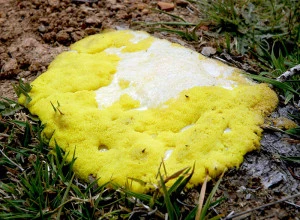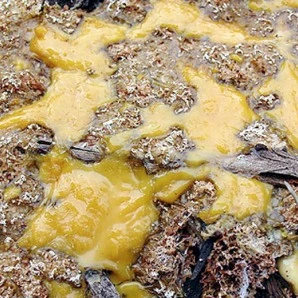“Dog Vomit Fungus”-Slime Mold
 In spring, when you have cleaned the yard of all its winter debris and laid down new hardwood mulch on all of your beds. Some time has passed and as you walk around enjoying your season-ready yard, you notice something sitting on top of your mulch! It is not very big, but it is very ugly, and quite frankly, it looks like your dog has puked up something that didn’t quite agree with him. What you are looking at is called, in gardening circles, Dog Vomit Fungus (slime mold). No really, that’s what it is called and it is more common that you’d think! Typically, spring weather conditions are perfect for this nasty looking fungus to appear in your mulched landscape beds.
In spring, when you have cleaned the yard of all its winter debris and laid down new hardwood mulch on all of your beds. Some time has passed and as you walk around enjoying your season-ready yard, you notice something sitting on top of your mulch! It is not very big, but it is very ugly, and quite frankly, it looks like your dog has puked up something that didn’t quite agree with him. What you are looking at is called, in gardening circles, Dog Vomit Fungus (slime mold). No really, that’s what it is called and it is more common that you’d think! Typically, spring weather conditions are perfect for this nasty looking fungus to appear in your mulched landscape beds.
 Why is it showing up in JULY? Lately, the weather has been very similar to our spring time conditions, cool and damp.
Why is it showing up in JULY? Lately, the weather has been very similar to our spring time conditions, cool and damp.
We have been getting calls reporting a strange slimy mess in landscape beds- almost like someone threw up in their gardens!!! It is a type of mushroom? Is it going to harm my shrubs or other landscape plant material?
Let me ease your concerns…
This isn’t a mushroom at all. It is a mold- a slime mold! It is actually more closely related to a single-celled organism. Slime mold has 2 life stages; First, “plasmodium” stage- it is just like a huge amoeba that creeps and moves like a blob over dead wood (including mulch) and other materials, engulfing, consuming, and “eating” different bacteria, yeast, and fungi.
In its beginning, the color of this mold is often bright yellow or sometimes a sickly orange. The color growth occurs when the mold is in its “fruiting stage”.
 The next stage in the life of this slime mold is quite depressing. Like many humans, the mold matures into a harder, larger mass that loses much of its bright attractive color. Although still able to project fear in some people at this stage, it becomes much harder to notice.
The next stage in the life of this slime mold is quite depressing. Like many humans, the mold matures into a harder, larger mass that loses much of its bright attractive color. Although still able to project fear in some people at this stage, it becomes much harder to notice.
When ready to reproduce—often when food runs out or conditions become too dry—it will dry out and enters a, dusty “sporangia” stage, producing spores that blow away to start new plasmodia in other areas.
The final notable stage is the spore stage. This is the time in its life cycle when millions of spores are released by rain, wildlife, or unsuspecting humans. The slime mold is relatively harmless to plants, animals and humans; it is more of a cosmetic issue. Therefore, there is no need to treat with chemicals, but simply wash it off with your hose, or scrape it away. If you choose to ignore it, it will be gone within a week or two. I personally, would not waste my time removing it.


Comments (0)
Sorry! The comments have been closed.